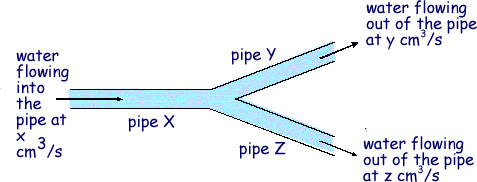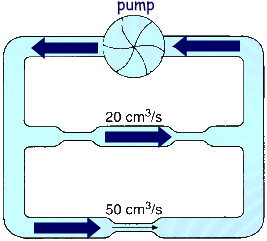Questions on Electric Circuits
Q18. The flow of water through tubes can be used as a model to explain some of the rules about electrical circuits.

The diagram shows a junction in a water pipe. The rate of flow in the pipes is measured in cm3/s.
(a) What is the relationship between the rate of flow in the three pipes, X, Y and Z?
X = Y + Z 
1 mark
(b) The diagram below shows a 'water circuit', in which water is forced round by a pump. The rates of flow at two places are written on the diagram.

(i) Complete the table below:
| Rate of water flow into the pump /(cm3/s) |
Rate of water flow out ofthe pump /(cm3/s) |
70 |
70 |

1 mark
(ii) The 'water circuit' can be used as a model of an electrical circuit. Each part of the 'water circuit' is equivalent to a part of an electrical circuit. What is the electrical equivalent of the water?
electrons OR charge 
1 mark
A family, who did not understand electricity very well, always made sure there was a bulb in each of the light fittings in their house. They were afraid that electricity would escape from an empty light socket when the switch was turned on.
(c) Explain why electricity does not escape from an empty light socket.
Electricity from the mains supply can only flow in conductors or metal
air is an insulator so electricity cannot flow through it 
1 mark
Total 4 marks








